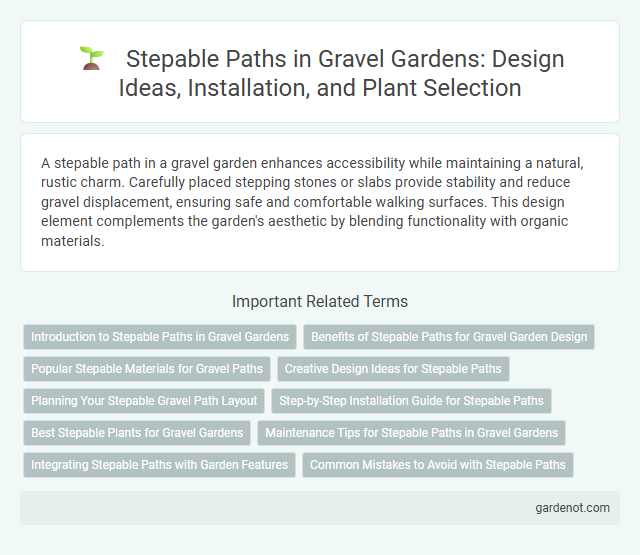A stepable path in a gravel garden enhances accessibility while maintaining a natural, rustic charm. Carefully placed stepping stones or slabs provide stability and reduce gravel displacement, ensuring safe and comfortable walking surfaces. This design element complements the garden's aesthetic by blending functionality with organic materials.
Introduction to Stepable Paths in Gravel Gardens
Stepable paths in gravel gardens create functional walkways that blend seamlessly with natural surroundings, enhancing both accessibility and aesthetics. These paths use compacted gravel combined with stepping stones or pavers to provide stable footing, reducing soil compaction and erosion. Incorporating drought-tolerant plants along edges complements the porous design, promoting water drainage and sustainable garden health.
Benefits of Stepable Paths for Gravel Garden Design
Stepable paths in gravel garden design enhance durability and reduce maintenance by preventing soil compaction and erosion. These paths improve accessibility, allowing easy navigation without disturbing plant roots, while promoting natural water drainage. Incorporating stepable materials such as pavers or stepping stones creates an aesthetically pleasing contrast that complements the organic texture of gravel.
Popular Stepable Materials for Gravel Paths
Popular stepable materials for gravel paths include flagstone, bluestone, and concrete pavers, offering durability and stability. These materials provide a solid walking surface while allowing gravel to fill gaps, enhancing drainage and weed control. Incorporating natural stone or permeable pavers creates a visually appealing and functional pathway in gravel garden designs.
Creative Design Ideas for Stepable Paths
Stepable paths in gravel gardens combine functionality with aesthetic appeal by integrating natural stone slabs, wooden planks, or concrete pavers that create visually striking walkways. Creative design ideas include alternating irregularly shaped stones with native ground covers or embedding solar-powered lights within gravel to enhance safety and ambiance. Utilizing materials like decomposed granite or recycled brick can add texture and sustainability while maintaining permeability for effective drainage.
Planning Your Stepable Gravel Path Layout
Planning your stepable gravel path layout involves selecting durable, flat stepping stones spaced evenly to ensure safe and comfortable walking. Incorporate drainage solutions beneath the gravel to prevent water pooling and soil erosion, enhancing longevity. Using landscape fabric under the gravel stabilizes the pathway while minimizing weed growth, creating a low-maintenance, aesthetically pleasing garden feature.
Step-by-Step Installation Guide for Stepable Paths
Stepable paths in gravel gardens enhance accessibility and aesthetic appeal by providing stable walking surfaces through loose gravel areas. Begin installation by marking the path layout and preparing a compacted sub-base to prevent shifting; next, place landscape fabric to inhibit weed growth and improve drainage. Finally, arrange stepping stones or pavers evenly spaced, backfill with gravel to lock stones in place, and compact the surface for durability.
Best Stepable Plants for Gravel Gardens
Stepable paths in gravel gardens benefit from durable, low-maintenance plants such as creeping thyme (Thymus serpyllum), blue star creeper (Isotoma fluviatilis), and Irish moss (Sagina subulata). These species tolerate foot traffic while enhancing the garden's texture and fragrance, making them ideal for integrating functionality and beauty. Their drought resistance and preference for well-drained soils align perfectly with gravel garden conditions.
Maintenance Tips for Stepable Paths in Gravel Gardens
Maintaining stepable paths in gravel gardens requires regular raking to prevent gravel displacement and ensure a level walking surface. Incorporate weed barriers beneath the gravel to minimize weed growth and reduce maintenance frequency. Periodically top up the gravel layer to maintain consistent depth and enhance durability of the path.
Integrating Stepable Paths with Garden Features
Stepable paths in gravel gardens enhance accessibility while seamlessly blending with natural elements such as flower beds, shrubs, and decorative stones. Incorporating materials like natural stone pavers or durable wooden stepping stones creates visual contrast and structural stability within the gravel surface. Thoughtful placement of stepable paths near water features or seating areas promotes harmonious flow and invites exploration of the garden's design.
Common Mistakes to Avoid with Stepable Paths
Common mistakes to avoid with stepable paths in a gravel garden include using uneven or overly loose gravel, which can create unstable footing and increase the risk of tripping. Neglecting proper edging allows gravel to spread beyond the path, leading to maintenance challenges and a less defined walkway. Failing to install a sturdy base layer beneath the gravel can result in sinking or shifting steps, reducing the path's durability and safety.
Stepable path Infographic

 gardenot.com
gardenot.com